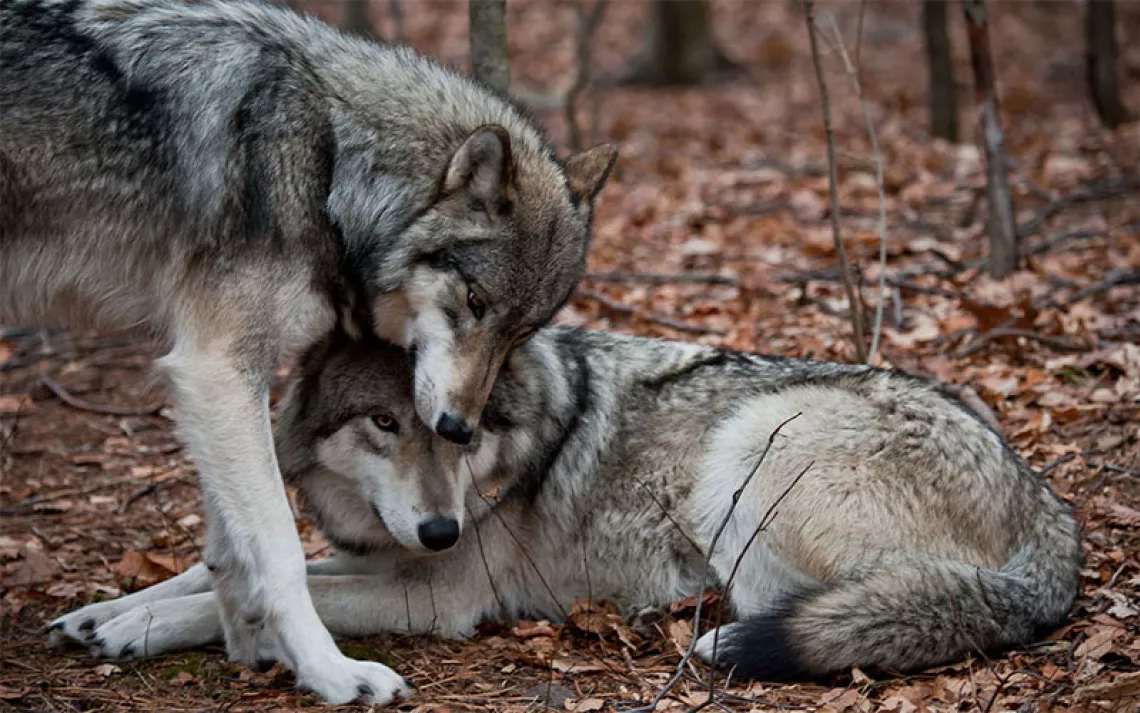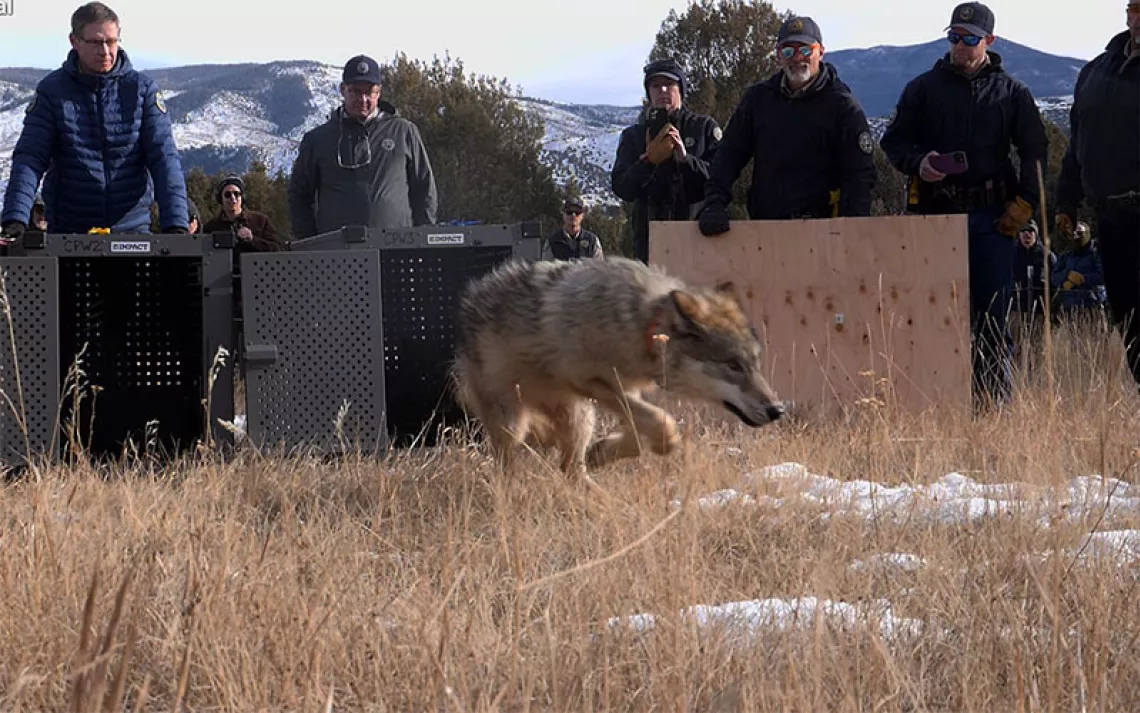Trump Administration Wants More Wolves off Endangered Species List
The latest in a (seemingly endless) fight over the controversial species

Photo by Waitandshoot/iStock
The Trump administration is proposing to remove the remaining federal protections for wolves, just as it attempted to do with grizzlies in late 2018. In March, acting interior secretary David Bernhardt announced that the US Fish and Wildlife Service would remove Endangered Species Act protections for gray wolves in the Lower 48. The move by the federal government is the latest in a long-standing battle among conservationists, hunters, and ranchers.
Since 1978, the FWS has actively managed three regional wolf populations for recovery: in the Northern Rockies, the Great Lakes region, and the Southwest, where the Mexican gray wolf subspecies resides. In 2003, the FWS deemed wolf populations healthy enough to change their ESA status from endangered to threatened, which sparked a 15-year-long legal battle between the agency and wildlife conservation groups. In 2011, Congress took the unusual step of delisting a nationally protected species in a single region—the gray wolves in the Northern Rockies—when it tacked a controversial rider on to the budget bill. That allowed states like Idaho and Montana to begin preparing their own management plans.
But almost every time the FWS has moved to drop wolves from the ESA, federal courts have struck down the proposals. For example, in 2013, the Obama administration proposed removing gray wolves’ endangered status across the contiguous United States, in all areas outside of designated Northern Rockies and western Great Lakes protected regions, though that decision was never finalized. In 2014, a federal court struck down a proposal to delist the western Great Lakes population. The ruling argued that the FWS failed to account for the impact of historical range loss, and also for how a partial delisting would impact the species nationwide. Then in 2017, the FWS stripped protections for Wyoming’s wolves, leading the state to adopt a notoriously lethal “predator management” plan, which has already resulted in a 25 percent decrease in the state’s wolf population.
In Montana and Idaho, wolf hunting has been on the rise in accordance with the new state management plans, although to a lesser degree than in Wyoming. According to Earthjustice, around 3,500 wolves have been killed since 2011 in Idaho, Montana, and Wyoming following the loss of federal protections. Currently, gray wolves have been delisted in Idaho, Montana, eastern Oregon, north central Utah, eastern Washington, and Wyoming, while retaining threatened status in Minnesota. (Earthjustice has a useful timeline of the wolf saga here.)
In its latest proposal, the Trump administration’s Fish and Wildlife Service argues that, based on the best available science and commercial information, gray wolves have sufficiently recovered. “Thanks to the partnerships involving states, tribes, conservation organizations, and private landowners galvanized under the ESA, the service is now able to propose turning management of all gray wolves back to the states and tribes who have been so central to the species’ recovery,” reads a FWS statement.
The proposal argues that under the ESA, the FWS is not required to restore a species to its entire historical range but rather to establish the species viability in the wild; the agency states, “there is no uniform definition for recovery and how recovery must be achieved.” The proposal acknowledges that a rise in legal human-caused mortality will follow the delisting but argues that “the high reproductive potential of wolves, and the innate behavior of wolves to disperse and locate social openings, allows wolf populations to withstand relatively high rates of human-caused mortality.”
That claim is one that wildlife advocates fiercely dispute, and they will likely continue to do so in the coming weeks when, per departmental regulations, scientific peer review and public comment periods are underway.
The FWS declined to be interviewed or respond to questions via email for this story. David Bernhardt, the former oil lobbyist currently leading the Interior Department and under fire for ties to industry, said in a press release, “The facts are clear and indisputable—the gray wolf no longer meets the definition of a threatened or endangered species. Today the wolf is thriving on its vast range, and it is reasonable to conclude it will continue to do so in the future.”
Conservation groups have balked at the Trump administration proposal, which, they say, would reverse wolves’ hard-won gains. Sylvia Fallon, senior director of the wildlife division at the National Resources Defense Council, says that the FWS has long resisted calls to implement a nationwide recovery plan, instead favoring piecemeal, regional management, even though the conservation community provided a road map to national recovery and management.
“I think [FWS wolf management] is a real truncated version of recovery and does not really bring the species to its full potential of recovery,” Fallon says. “For wolves to be recovered nationally, we would like to see them occupying the remaining available habitat in their historic range.” Fallon points to areas like Colorado, the Northeast, and parts of California as having ample suitable habitat for wolf rehabilitation.
At the time of European contact, there may have been as many as 2 million wolves inhabiting North America. After a centuries-long extermination campaign, wolf populations hit a nadir of around 1,000 animals, mostly living in the north woods of Minnesota, in the early 20th century. Today, an estimated 6,000 wolves are spread across the Lower 48. There are as many as 11,000 wolves in Alaska, where the species has never had ESA protection. According to Alaska Fish and Game, about 1,300 wolves are killed by hunters and trappers annually in the state, with up to 200 more taken by wildlife managers each year. Today, wolves occupy somewhere between 5 and 15 percent of their historical range across the Lower 48.
Colette Adkins, a senior attorney at the Center for Biological Diversity, agrees that more historical range could support wolves. Adkins sees this latest delisting effort as largely political, characteristic of a distinctly antiscience administration.
“We know from experience that states can't be trusted to sustainably manage wolves,” Adkins says. “When they lose their federal protections, they get subjected to aggressive trophy hunting, trapping, killing at the behest of the agricultural [livestock] industry.” Adkins points to Wisconsin, where the predator management plan aims for 350 wolves, or less than half of the population of roughly 900. She acknowledges that some states offer strong protections, but that those tend to be in areas where the animal is scarce, such as California and Colorado.
To a large extent, wolves will always be a highly contentious issue. Many cattle ranchers and sheep herders have long opposed the presence of wolves on the landscape. Fallon has seen some encouraging dialogue between ranchers and wolf advocates and is hopeful that people and wolves can coexist. “We’ve actually seen a lot of progress in the Northern Rockies in the last couple of years with ranchers making some changes to their practices,” Fallon says. “I think there’s huge potential there—particularly if we can help provide resources to help ranchers implement these nonlethal practices, to prevent conflicts from happening in the first place.”
In some areas, compensation programs provide cash payments to ranchers if it’s confirmed that wolves killed their livestock. By providing reimbursement, conservationists and managers are hoping to ease the pressure from industry and help assuage vitriol against wolves. But while some programs have been hailed as successful, not everyone in pleased. In Oregon, critics fear that the program is being abused by ranchers, while ranchers counter that livestock kills and wolf populations are undercounted.
Adkins is skeptical about the prospect for reaching consensus with the livestock industry. She emphasizes that there’s ample public support for wolf conservation. “The first step is to try to make sure that this proposal is never finalized at all,” she says. “But if the Fish and Wildlife Service does go ahead with the final rule, absolutely we will bring them to court.”
This article has been updated since publication.
 The Magazine of The Sierra Club
The Magazine of The Sierra Club



